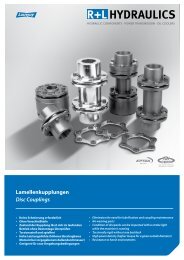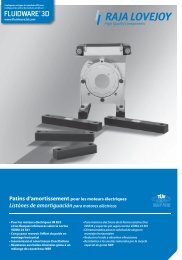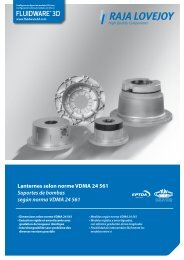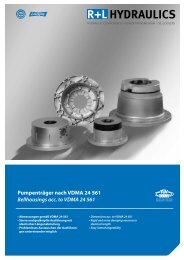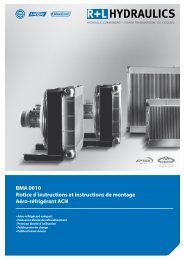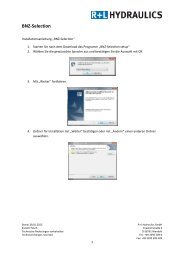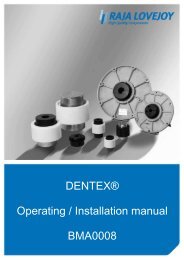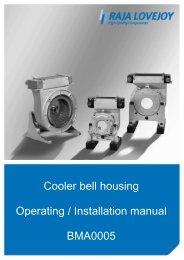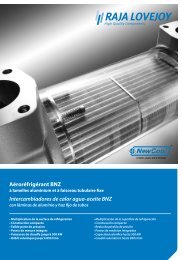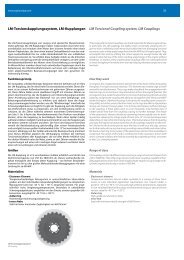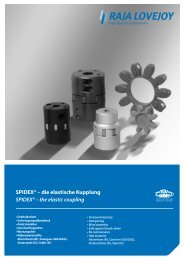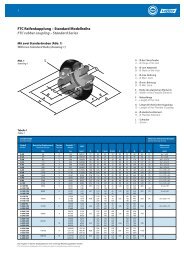Erfolgreiche ePaper selbst erstellen
Machen Sie aus Ihren PDF Publikationen ein blätterbares Flipbook mit unserer einzigartigen Google optimierten e-Paper Software.
35<br />
LM-Torsionskupplung – Auswahl<br />
Benutzen Sie die folgenden 3 Schritte in Verbindung mit den technischen<br />
Daten unserer Maßtabellen, die in den folgenden Abschnitten enthalten<br />
sind, um eine vorläufige Kupplungsauswahl zu treffen:<br />
1. Anwendungsdrehmoment<br />
Wählen Sie eine Kupplungsgröße mit einem Nenndrehmoment (T KN ) größer<br />
oder gleich dem Anwendungsdrehmoment (T) mit folgender Gleichung berechnet<br />
aus:<br />
T = kW * 9550/U/min<br />
vorausgesetzt<br />
T < T KN *S t1<br />
wobei S t1 der in der Tabelle gefundene Temperaturfaktor für das nominale<br />
Drehmoment ist. Diese Zahl ist typischerweise mindestens 0,6 oder 0,7<br />
(für die typische Umgebungstemperatur von 60 bis 70 °C innerhalb des<br />
Schwungradgehäuses).<br />
2. SAE-Schwungradgröße<br />
Wählen Sie die entsprechende SAE J620 Flanschgröße passend zu Ihrem<br />
Schwungrad aus.<br />
3. Wellenmaße<br />
Stellen Sie sicher, dass der maximale Bohrungsdurchmesser der Kupplung<br />
das Maß Ihrer angetriebenen Welle aufnimmt. Die Nabenlänge der Kupplung<br />
kann, wenn erforderlich, gekürzt werden.<br />
WICHTIG:<br />
Die endgültige Auswahl der Kupplungsgröße erfordert eine Verifizierung<br />
durch eine Torsionsvibrationsanalyse.<br />
Diese Analyse identifiziert kritische Drehzahlbereiche und stellt sicher, dass<br />
keine Bedingungen für exzessive dauernde oder kurzzeitige Resonanzen im<br />
normalen Betriebsdrehzahlenbereich des Systems vorhanden sind.<br />
LM-Kupplungen sind robust, zuverlässig und einzigartig in ihrer Fähigkeit,<br />
Torsionsvibrationsprobleme in bestimmten Anwendungen zu lösen. Wie jedoch<br />
bei allen Torsionskupplungen kann eine ungeeignete Kupplungsauswahl<br />
zu instabilen Bedingungen führen, welche die Kupplung und den Rest<br />
des Antriebsstrangs in Gefahr bringt. Falls erforderlich kann R+L HYDRAULICS<br />
die Torsionsvibrationsanalyse für Sie durchführen. Füllen Sie einfach das Arbeitsblatt<br />
auf Seite 10 aus und faxen Sie es uns.<br />
Weitere Details hinsichtlich der auf dieser Analyse basierenden Kupplungsauswahl<br />
finden Sie auf Seite 8 und 9.<br />
LM Torsional Coupling selection<br />
Use the following 3 steps in conjunction with the technical data and dimension<br />
tables contained in the following sections to make the preliminary coupling selection:<br />
1. Application torque<br />
Select a coupling size with a nominal torque rating (T KN ) greater or equal to the<br />
application torque (T) calculated with the equation:<br />
T = kW * 9550/RPM<br />
provided<br />
T < T KN *S t1<br />
where S t1 is the temperature factor for nominal torque found from the chart.<br />
This number will typically be at least .6 or .7 (for typical ambient temperature of<br />
at least 60 to 70°C inside the flywheel housing).<br />
2. SAE flywheel size<br />
Select the appropriate SAE J620 flange size to match your flywheel.<br />
3. Shaft dimensions<br />
Make sure maximum bore capacity of coupling will accommodate the dimensions<br />
of your driven shaft. Coupling hub length can usually be shortened if necessary<br />
to fit into tight space envelopes.<br />
IMPORTANT:<br />
Final selection of coupling size requires verification by torsional vibration<br />
analysis.<br />
This analysis will identify the location of critical speeds and confirm the absence<br />
of excessive steady-state and peak resonance conditions over the normal operating<br />
cycle of the equipment.<br />
LM couplings are robust, reliable and unique in their ability to solve torsional<br />
vibration problems in certain applications. But as with all torsional couplings,<br />
inappropriate coupling selection can lead to unstable conditions that place the<br />
coupling as well as the rest of the drive train at danger. R+L HYDRAULICS can<br />
perform the torsional vibration analysis for you if necessary. Simply complete<br />
the worksheet found on page 10 and fax it to us.<br />
You can find more details regarding coupling selection based on this analysis<br />
on pages 8 and 9.




